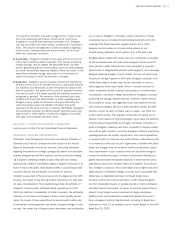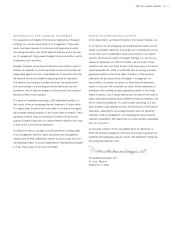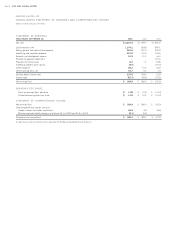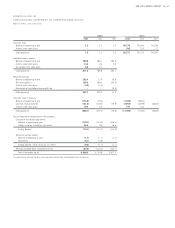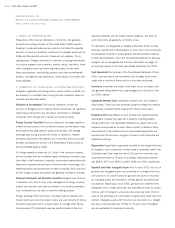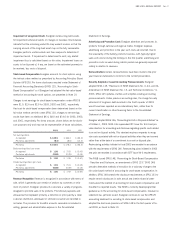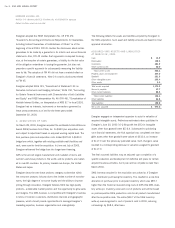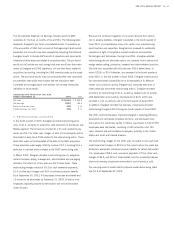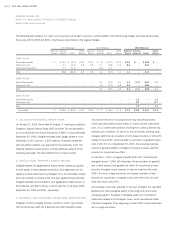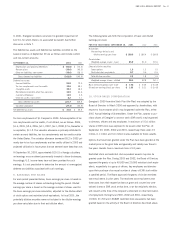Energizer 2003 Annual Report Download - page 29
Download and view the complete annual report
Please find page 29 of the 2003 Energizer annual report below. You can navigate through the pages in the report by either clicking on the pages listed below, or by using the keyword search tool below to find specific information within the annual report.
ENR 2003 ANNUAL REPORT Page 27
Impairment of Long-Lived Assets Energizer reviews long-lived assets
for impairment whenever events or changes in business circumstances
indicate that the remaining useful life may warrant revision or that the
carrying amount of the long-lived asset may not be fully recoverable.
Energizer performs undiscounted cash flow analyses to determine if
impairment exists. If impairment is determined to exist, any related
impairment loss is calculated based on fair value. Impairment losses on
assets to be disposed of, if any, are based on the estimated proceeds to
be received, less costs of disposal.
Stock-based Compensation Energizer accounts for stock options using
the intrinsic value method as prescribed by Accounting Principles Board
Opinion (APB 25). Pro forma disclosures required under Statement of
Financial Accounting Standards (SFAS) 123, “Accounting for Stock-
Based Compensation” as if Energizer had adopted the fair value-based
method of accounting for stock options, are presented in Note 10.
Charges to net earnings for stock-based compensation under APB 25
were $1.9, $2.6 and $2.5 for 2003, 2002 and 2001, respectively.
Had cost for stock-based compensation been determined based on the
fair value method set forth under SFAS 123, charges to net earnings
would have been an additional $6.4, $8.0 and $14.0 for 2003, 2002,
and 2001, respectively. Pro forma amounts shown below are for disclo-
sure purposes only and may not be representative of future calculations.
2003 2002 2001
Net earnings/(loss):
As reported $ 169.9 $ 186.4 $ (39.0)
Pro forma adjustments (6.4) (8.0) (14.0)
Pro forma $ 163.5 $ 178.4 $ (53.0)
Basic earnings/(loss) per share:
As reported $ 1.98 $2.05 $ (0.42)
Pro forma adjustments (0.08) (0.09) (0.15)
Pro forma $ 1.90 $ 1.96 $ (0.57)
Diluted earnings/(loss) per share:
As reported $ 1.93 $2.01 $ (0.42)
Pro forma adjustments (0.08) (0.09) (0.15)
Pro forma $ 1.85 $ 1.92 $ (0.57)
Revenue Recognition Revenue is recognized in accordance with terms of
sale, which is generally upon receipt of product by customers or ship-
ment of product. Energizer provides its customers a variety of programs
designed to promote sales of its products. Promotional payments and
allowances that represent primarily a reduction in price paid by a retail
customer, distributor, wholesaler or ultimate consumer are recorded in
net sales. The provision for doubtful accounts receivable is included in
selling, general and administrative expense in the Consolidated
Statement of Earnings.
Advertising and Promotion Costs Energizer advertises and promotes its
products through national and regional media. Energizer expenses
advertising and promotion in the year such costs are incurred. Due to
the seasonality of the battery products business, with typically higher
sales and volume during the holidays in the first quarter, advertising and
promotion costs incurred during interim periods are generally expensed
ratably in relation to revenues.
Reclassifications Certain reclassifications have been made to the prior
year financial statements to conform to the current presentation.
Recently Adopted or Issued Accounting Pronouncements Energizer
adopted SFAS 145, “Rescission of FASB Statements No. 4, 44, and 64,
Amendment of FASB Statement No. 13, and Technical Corrections,” in
2003. SFAS 145 updates, clarifies and simplifies existing accounting
pronouncements. Under previous accounting rules, the charge for early
retirement of long-term debt recorded in the fourth quarter of 2003
would have been reported as an extraordinary item, rather than its
current classification in other financing items in the Consolidated
Statement of Earnings.
Energizer adopted SFAS 146, “Accounting for Exit or Disposal Activities” as
of October 1, 2003. SFAS 146 supercedes EITF Issue No. 94-3 and pro-
vides direction for accounting and disclosure regarding specific costs related
to an exit or disposal activity. This standard requires companies to recog-
nize costs associated with exit or disposal activities when they are incurred
rather than at the date of a commitment to an exit or disposal plan.
Restructuring activities initiated in fiscal 2003 are recorded in accordance
with the requirements of SFAS 146. Restructuring plans initiated in 2002
and prior are recorded in accordance with EITF Issue 94-3 requirements.
The FASB issued SFAS 148, “Accounting for Stock-Based Compensation
- Transition and Disclosure, an amendment of SFAS 123.” SFAS 148
provides alternative methods of transition for a voluntary change to the
fair value based method of accounting for stock-based compensation. In
addition, SFAS 148 amends the disclosure requirements of SFAS 123 to
require certain disclosures in both annual and interim financial state-
ments about the method of accounting for stock-based compensation and
the effect on reported results. The FASB is currently developing further
guidance as to the accounting for stock-based compensation; however no
statement has yet been issued. Energizer continues to use the APB 25
accounting treatment for recording its stock-based compensation and
adopted the disclosure provisions of SFAS 148 in the first quarter of fis-
cal 2003, as found in Note 10.




